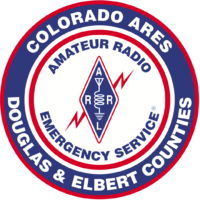
Ham radio operators from the Amateur Radio Emergency Services of Douglas and Elbert Counties (ARESDEC) will be participating in a national amateur radio exercise from noon on Saturday until noon on Sunday, June 22-23. The event is ARRL Field Day (www.arrl.org/FieldDay), an annual amateur radio activity organized since 1933 by ARRL, The National Association for Amateur Radio in the United States. The Field Day event encourages hams to set up antennas and radios outdoors in the “Field” and make as many radio contacts with other hams as is possible in a 24-hour period.
The purpose of Field Day is to simulate a national level disaster where normal communications infrastructure is impacted over a wide area. Hams, also known as amateur radio operators, have a long history of providing communications during local and national emergencies and disasters. The Amateur Radio Emergency Service (ARES) of Douglas and Elbert Counties has organized a Field Day location in the Parker area.
Beginning at 12:00 PM on Saturday June 22nd, and continuing for 24 hours until 12:00 PM on Sunday, June 23rd, ARES of Douglas and Elbert Counties will be making ham radio contacts from a Field Day location at 2251 Hess Road in Parker. The public is invited to check out Field Day and come see what ham radio is about.

Hams from across North America ordinarily participate in Field Day by establishing temporary ham radio stations in public locations to demonstrate their skill and service. Their use of radio signals, which reach beyond borders, bring people together while providing essential communication in the service of communities. Field Day highlights ham radio’s ability to work reliably under any conditions from almost any location and create an independent, wireless communications network.
Some hams from Douglas and Elbert counties will also use their radio stations set up in their homes or taken to their backyards and other locations to operate individually or with their families. Many hams have portable radio communication capability that includes alternative energy sources such as generators, solar panels, and batteries to power their equipment.
This year’s event is also noteworthy given that a particularly active hurricane season is predicted. “Hams have a long history of serving our communities when storms or other disasters damage critical communication infrastructure, including cellphone towers,” said Dick Williams, Emergency Coordinator for ARESDEC (call sign K8ZTT). “Ham radio functions completely independently of the internet and phone systems, and a station can be set up almost anywhere in minutes. Hams can quickly raise a wire antenna in a tree or on a mast, connect it to a radio and power source, and communicate effectively with others,” Williams added.
During Field Day 2023, more than 40,000 hams participated from thousands of locations across North America. According to ARRL, there are more than 750,000 amateur radio licensees in the US, and an estimated 3 million worldwide.
Among the tenets of the Amateur Radio Service is developing and practicing skills in radio technology and radio communications, and even contributing to international goodwill. Hams range in age from as young as 9 to older than 100. A self-study license guide is available from ARRL: The ARRL Ham Radio License Manual (www.arrl.org/shop/Ham-Radio-License-Manual) and for Kindle (https://read.amazon.com/kp/embed?asin=B07DFSW94G).



